A Long-Term Comparison between the AethLabs MA350 and Aerosol Magee Scientific AE33 Black Carbon Monitors in the Greater Salt Lake City Metropolitan Area
Abstract
1. Introduction
1.1. Background on Black Carbon
1.2. Source Apportionment and “Aethalometer Model”
2. Materials and Methods
2.1. Location and Study Period
2.2. Instrument Operation and Parameters
2.3. Data Treatment
2.3.1. AE33 Data Cleaning
2.3.2. MA350 Data Cleaning & Processing
2.3.3. Hourly and Daily Averaging
2.4. Source Apportionment
2.4.1. Theoretical Basis for Source Apportionment
2.4.2. Mathematical Foundations for the MA350 Source Apportionment Feature
3. Results
3.1. Minute Resolved Findings
3.2. Hourly Averaged Findings
3.3. Daily Averaged Findings
4. Discussion
4.1. Implications
4.2. Limitations
4.3. Health and Policy Applications
5. Conclusions
Author Contributions
Funding
Institutional Review Board Statement
Informed Consent Statement
Data Availability Statement
Acknowledgments
Conflicts of Interest
References
- Chowdhury, S.; Pozzer, A.; Haines, A.; Klingmueller, K.; Muenzel, T.; Paasonen, P.; Sharma, A.; Venkataraman, C.; Lelieveld, J. Global health burden of ambient PM2.5 and the contribution of anthropogenic black carbon and organic aerosols. Environ. Int. 2022, 159, 107020. [Google Scholar] [CrossRef] [PubMed]
- Janssen, N.A.; Gerlofs-Nijland, M.E.; Lanki, T.; Salonen, R.O.; Cassee, F.; Hoek, G.; Fischer, P.; Brunekreef, B.; Krzyzanowski, M. Health Effects of Black Carbon; World Health Organization, Regional Office for Europe: Copenhagen, Denmark, 2012. [Google Scholar]
- Grady, S.T.; Koutrakis, P.; Hart, J.E.; Coull, B.A.; Schwartz, J.; Laden, F.; Zhang, J.J.; Gong, J.; Moy, M.L.; Garshick, E. Indoor black carbon of outdoor origin and oxidative stress biomarkers in patients with chronic obstructive pulmonary disease. Environ. Int. 2018, 115, 188–195. [Google Scholar] [CrossRef] [PubMed]
- Watson, J.G.; Chow, J.C.; Chen, L.-W.A. Summary of organic and elemental carbon/black carbon analysis methods and intercomparisons. Aerosol Air Qual. Res. 2005, 5, 65–102. [Google Scholar] [CrossRef]
- Sandradewi, J.; Prévôt, A.; Alfarra, M.; Szidat, S.; Wehrli, M.; Ruff, M.; Weimer, S.; Lanz, V.; Weingartner, E.; Perron, N. Comparison of several wood smoke markers and source apportionment methods for wood burning particulate mass. Atmos. Chem. Phys. Discuss. 2008, 8, 8091–8118. [Google Scholar]
- AethLabs. MicroAeth® MA350 Black Carbon Monitor. Available online: https://aethlabs.com/sites/all/content/microaeth/ma350/microAeth%20MA350%20Specifications%20Sheet%20Rev%2003%20Updated%20Oct%202021.pdf (accessed on 26 November 2023).
- Aerosol Magee Scientific. Aethalometer® AE33. Available online: https://www.aerosolmageesci.com/products/aerosol-magee-scientific-aethalometer/ (accessed on 12 December 2023).
- Sandradewi, J.; Prévôt, A.S.; Szidat, S.; Perron, N.; Alfarra, M.R.; Lanz, V.A.; Weingartner, E.; Baltensperger, U. Using aerosol light absorption measurements for the quantitative determination of wood burning and traffic emission contributions to particulate matter. Environ. Sci. Technol. 2008, 42, 3316–3323. [Google Scholar] [CrossRef] [PubMed]
- Aerosol Magee Scientific. Advanced Measurement of Aerosol Black Carbon. Available online: https://aerosolmageesci.com/webdocuments/AE33_brochure.pdf (accessed on 12 December 2023).
- Martinsson, J.; Abdul Azeem, H.; Sporre, M.K.; Bergström, R.; Ahlberg, E.; Öström, E.; Kristensson, A.; Swietlicki, E.; Eriksson Stenström, K. Carbonaceous aerosol source apportionment using the Aethalometer model–evaluation by radiocarbon and levoglucosan analysis at a rural background site in southern Sweden. Atmos. Chem. Phys. 2017, 17, 4265–4281. [Google Scholar] [CrossRef]
- Zotter, P.; Herich, H.; Gysel, M.; El-Haddad, I.; Zhang, Y.; Močnik, G.; Hüglin, C.; Baltensperger, U.; Szidat, S.; Prévôt, A.S. Evaluation of the absorption Ångström exponents for traffic and wood burning in the Aethalometer-based source apportionment using radiocarbon measurements of ambient aerosol. Atmos. Chem. Phys. 2017, 17, 4229–4249. [Google Scholar] [CrossRef]
- Helin, A.; Niemi, J.V.; Virkkula, A.; Pirjola, L.; Teinilä, K.; Backman, J.; Aurela, M.; Saarikoski, S.; Rönkkö, T.; Asmi, E. Characteristics and source apportionment of black carbon in the Helsinki metropolitan area, Finland. Atmos. Environ. 2018, 190, 87–98. [Google Scholar] [CrossRef]
- Sandradewi, J.; Prévôt, A.; Weingartner, E.; Schmidhauser, R.; Gysel, M.; Baltensperger, U. A study of wood burning and traffic aerosols in an Alpine valley using a multi-wavelength Aethalometer. Atmos. Environ. 2008, 42, 101–112. [Google Scholar] [CrossRef]
- Favez, O.; El Haddad, I.; Piot, C.; Boréave, A.; Abidi, E.; Marchand, N.; Jaffrezo, J.-L.; Besombes, J.-L.; Personnaz, M.-B.; Sciare, J. Inter-comparison of source apportionment models for the estimation of wood burning aerosols during wintertime in an Alpine city (Grenoble, France). Atmos. Chem. Phys. 2010, 10, 5295–5314. [Google Scholar] [CrossRef]
- Utah Division of Air Quality. Utah Division of Air Quality 2020 Annual Report; Utah Division of Air Quality: Salt Lake City, UT, USA, 2021.
- Weingartner, E.; Saathoff, H.; Schnaiter, M.; Streit, N.; Bitnar, B.; Baltensperger, U. Absorption of light by soot particles: Determination of the absorption coefficient by means of aethalometers. J. Aerosol Sci. 2003, 34, 1445–1463. [Google Scholar] [CrossRef]
- Drinovec, L.; Močnik, G.; Zotter, P.; Prévôt, A.; Ruckstuhl, C.; Coz, E.; Rupakheti, M.; Sciare, J.; Müller, T.; Wiedensohler, A. The “dual-spot” Aethalometer: An improved measurement of aerosol black carbon with real-time loading compensation. Atmos. Meas. Tech. 2015, 8, 1965–1979. [Google Scholar] [CrossRef]
- Virkkula, A.; Mäkelä, T.; Hillamo, R.; Yli-Tuomi, T.; Hirsikko, A.; Hämeri, K.; Koponen, I.K. A simple procedure for correcting loading effects of aethalometer data. J. Air Waste Manag. Assoc. 2007, 57, 1214–1222. [Google Scholar] [CrossRef] [PubMed]
- Chakraborty, M.; Giang, A.; Zimmerman, N. Performance evaluation of portable dual-spot micro-aethalometers for source identification of black carbon aerosols: Application to wildfire smoke and traffic emissions in the Pacific Northwest. Atmos. Meas. Tech. Discuss. 2022, 2022, 2333–2352. [Google Scholar] [CrossRef]
- Aerosol Magee Scientific. AE33 Aethalometer®. Available online: https://aerosolmageesci.com/webdocuments/AE33_spec_sheet.pdf (accessed on 12 December 2023).
- AethLabs. microAeth®/MA350 Tech Specs. Available online: https://aethlabs.com/microaeth/ma350/tech-specs (accessed on 12 December 2023).
- R Core Team. A Language and Environment for Statistical Computing; R Foundation for Statistical Computing: Vienna, Austria, 2021; Available online: https://www.R-project.org (accessed on 13 December 2023).
- Allen, G. Aethalometer® Training Course: Magee AE33/TAPI-633. Available online: https://www.epa.gov/sites/default/files/2021-03/documents/aethalometer_training.pdf (accessed on 10 December 2023).
- Hansen, A.D.; Rosen, H.; Novakov, T. The aethalometer—An instrument for the real-time measurement of optical absorption by aerosol particles. Sci. Total Environ. 1984, 36, 191–196. [Google Scholar] [CrossRef]
- Gundel, L.; Dod, R.; Rosen, H.; Novakov, T. The relationship between optical attenuation and black carbon concentration for ambient and source particles. Sci. Total Environ. 1984, 36, 197–202. [Google Scholar] [CrossRef]
- AethLabs. What Mass Absorption Cross Section Is Used for the microAeth? Available online: https://help.aethlabs.com/s/article/What-mass-absorption-cross-section-is-used-for-the-microAeth (accessed on 26 November 2023).
- Li, A.F.; Zhang, K.M.; Allen, G.; Zhang, S.; Yang, B.; Gu, J.; Hashad, K.; Sward, J.; Felton, D.; Rattigan, O. Ambient sampling of real-world residential wood combustion plumes. J. Air Waste Manag. Assoc. 2022, 72, 710–719. [Google Scholar] [CrossRef]
- McCarty, J.L.; Korontzi, S.; Justice, C.O.; Loboda, T. The spatial and temporal distribution of crop residue burning in the contiguous United States. Sci. Total Environ. 2009, 407, 5701–5712. [Google Scholar] [CrossRef]
- Mouteva, G.O.; Randerson, J.T.; Fahrni, S.M.; Bush, S.E.; Ehleringer, J.R.; Xu, X.; Santos, G.M.; Kuprov, R.; Schichtel, B.A.; Czimczik, C.I. Using radiocarbon to constrain black and organic carbon aerosol sources in Salt Lake City. J. Geophys. Res. Atmos. 2017, 122, 9843–9857. [Google Scholar] [CrossRef]
- Utah Division of Air Quality. Wood Stove and Fireplace Conversion Assistance Program. Available online: https://deq.utah.gov/air-quality/wood-stove-conversion-assistance-program (accessed on 26 November 2023).
- Mulloy, P.G. Smoothing data with faster moving averages. Stock. Commod. 1994, 12, 11–19. [Google Scholar]
- Patarasuk, R.; Gurney, K.R.; O’Keeffe, D.; Song, Y.; Huang, J.; Rao, P.; Buchert, M.; Lin, J.C.; Mendoza, D.; Ehleringer, J.R. Urban high-resolution fossil fuel CO2 emissions quantification and exploration of emission drivers for potential policy applications. Urban Ecosyst. 2016, 19, 1013–1039. [Google Scholar] [CrossRef]
- Kuula, J.; Friman, M.; Helin, A.; Niemi, J.V.; Aurela, M.; Timonen, H.; Saarikoski, S. Utilization of scattering and absorption-based particulate matter sensors in the environment impacted by residential wood combustion. J. Aerosol Sci. 2020, 150, 105671. [Google Scholar] [CrossRef]
- Blanco-Donado, E.P.; Schneider, I.L.; Artaxo, P.; Lozano-Osorio, J.; Portz, L.; Oliveira, M.L. Source identification and global implications of black carbon. Geosci. Front. 2022, 13, 101149. [Google Scholar] [CrossRef]
- Cuesta-Mosquera, A.; Močnik, G.; Drinovec, L.; Müller, T.; Pfeifer, S.; Minguillón, M.C.; Briel, B.; Buckley, P.; Dudoitis, V.; Fernández-García, J. Intercomparison and characterization of 23 Aethalometers under laboratory and ambient air conditions: Procedures and unit-to-unit variabilities. Atmos. Meas. Tech. 2021, 14, 3195–3216. [Google Scholar] [CrossRef]
- Shairsingh, K.K.; Jeong, C.-H.; Wang, J.M.; Evans, G.J. Characterizing the spatial variability of local and background concentration signals for air pollution at the neighbourhood scale. Atmos. Environ. 2018, 183, 57–68. [Google Scholar] [CrossRef]
- Bares, R.; Lin, J.C.; Hoch, S.W.; Baasandorj, M.; Mendoza, D.L.; Fasoli, B.; Mitchell, L.; Catharine, D.; Stephens, B.B. The Wintertime Covariation of CO2 and Criteria Pollutants in an Urban Valley of the Western United States. J. Geophys. Res. Atmos. 2018, 123, 2684–2703. [Google Scholar] [CrossRef]
- Childs, M.L.; Li, J.; Wen, J.; Heft-Neal, S.; Driscoll, A.; Wang, S.; Gould, C.F.; Qiu, M.; Burney, J.; Burke, M. Daily Local-Level Estimates of Ambient Wildfire Smoke PM2.5 for the Contiguous US. Environ. Sci. Technol. 2022, 56, 13607–13621. [Google Scholar] [CrossRef]
- Jakus, P.M.; Kim, M.-K.; Martin, R.C.; Hammond, I.; Hammill, E.; Mesner, N.; Stout, J. Wildfire in Utah: The Physical and Economic Consequences of Wildfire; Utah State University: Logan, UT, USA, 2017. [Google Scholar]
- Liu, Y.; Austin, E.; Xiang, J.; Gould, T.; Larson, T.; Seto, E. Health impact assessment of the 2020 Washington State wildfire smoke episode: Excess health burden attributable to increased PM2.5 exposures and potential exposure reductions. GeoHealth 2021, 5, e2020GH000359. [Google Scholar] [CrossRef]
- Mallia, D.V. Simulating High Impact Wildfire and Wind-Blown Dust Events Using Improved Atmospheric Modeling Methods. Ph.D. Thesis, The University of Utah, Salt Lake City, UT, USA, 2018. [Google Scholar]
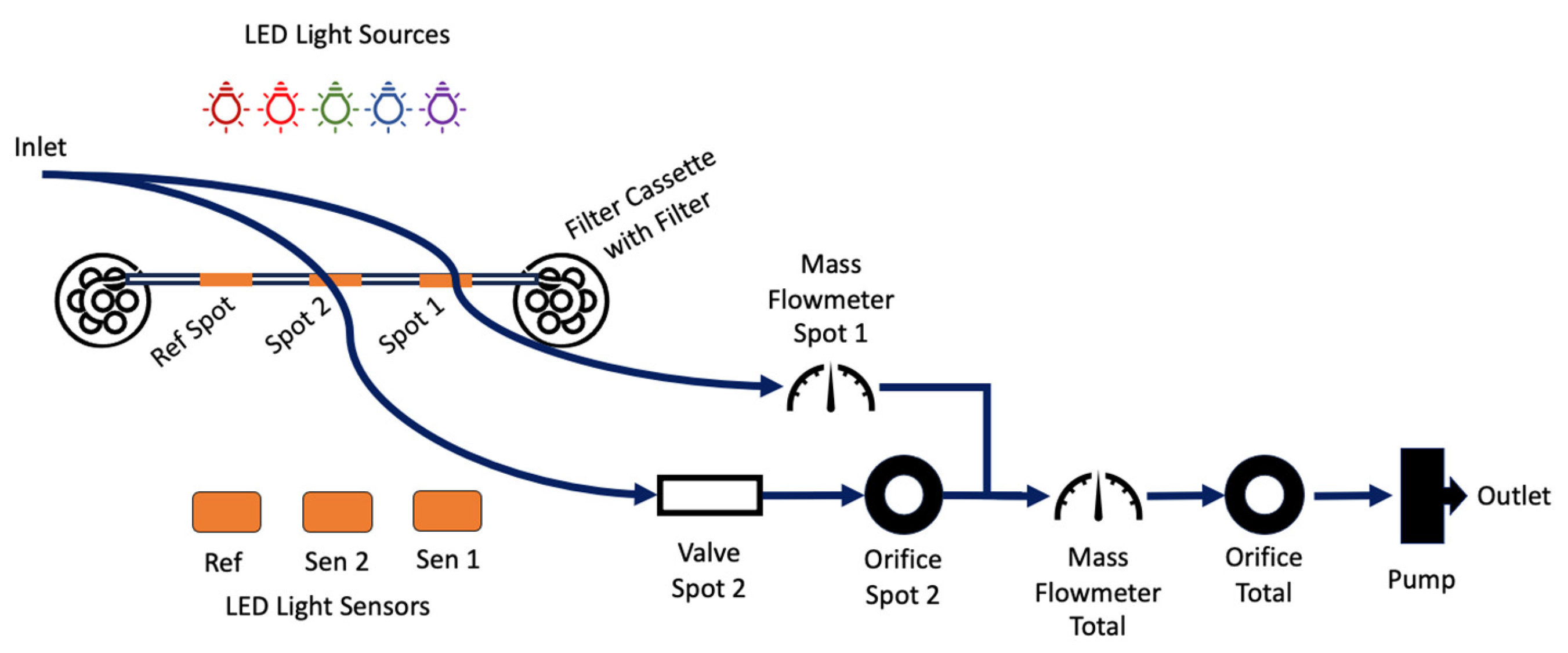
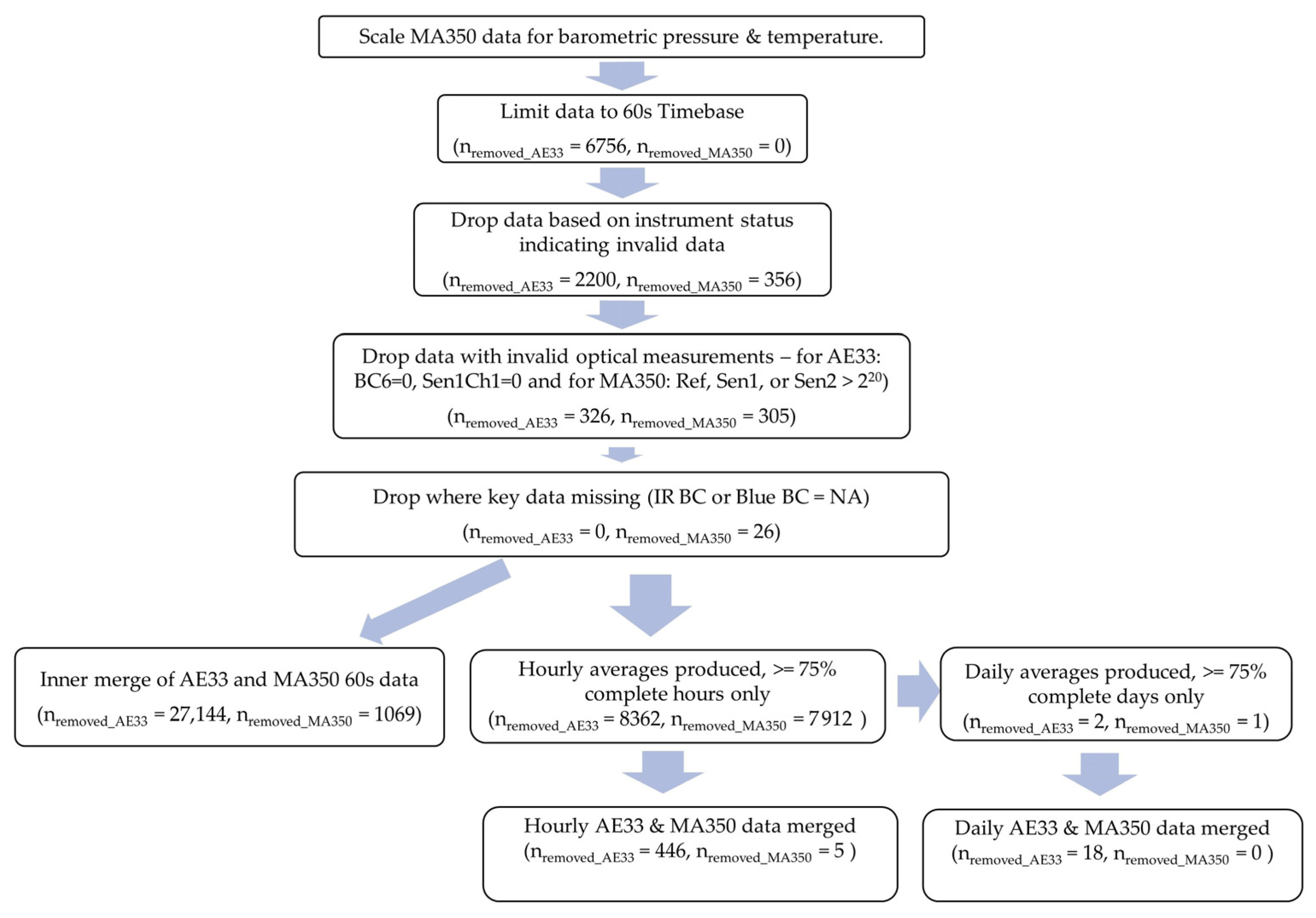
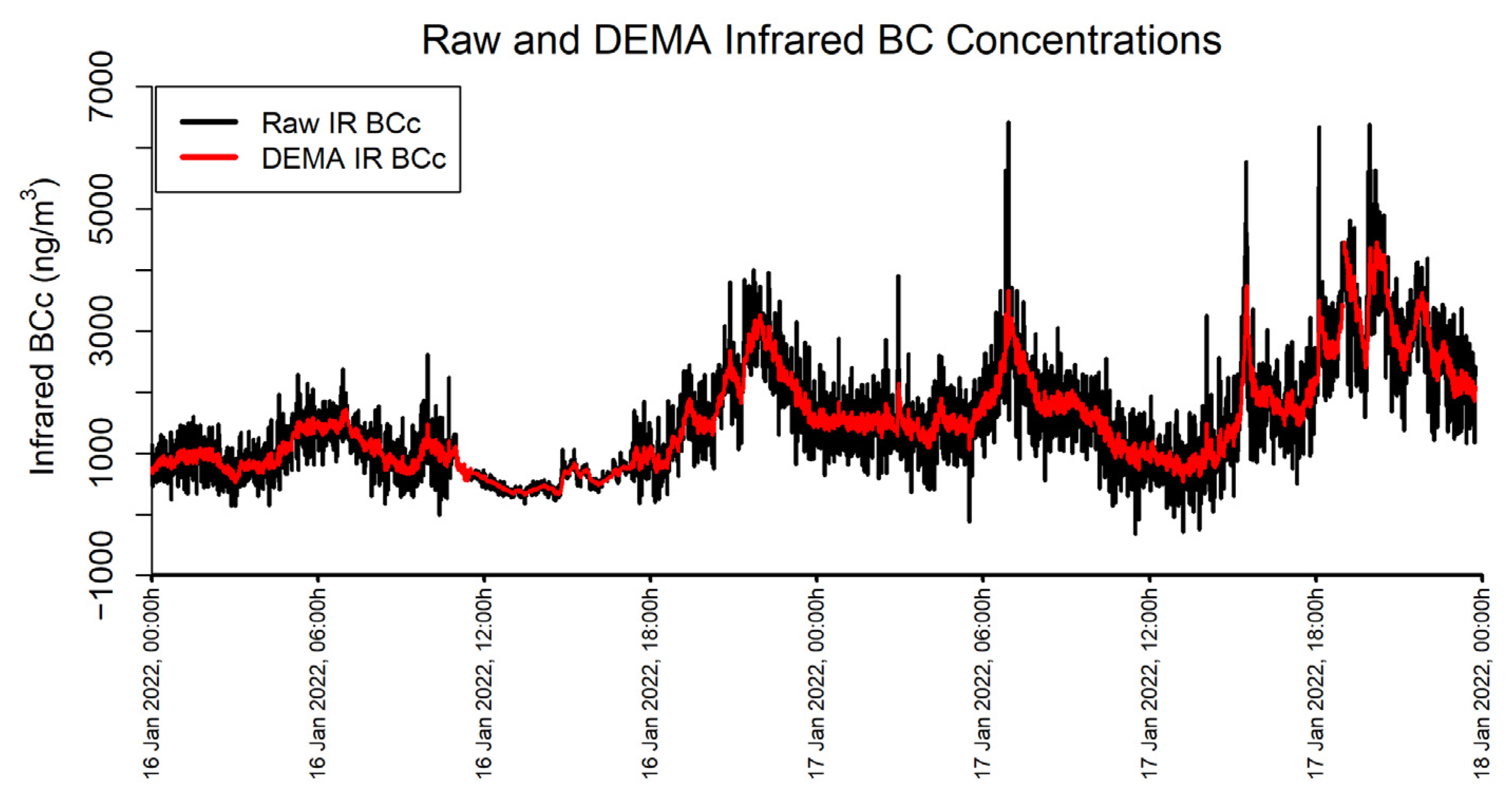
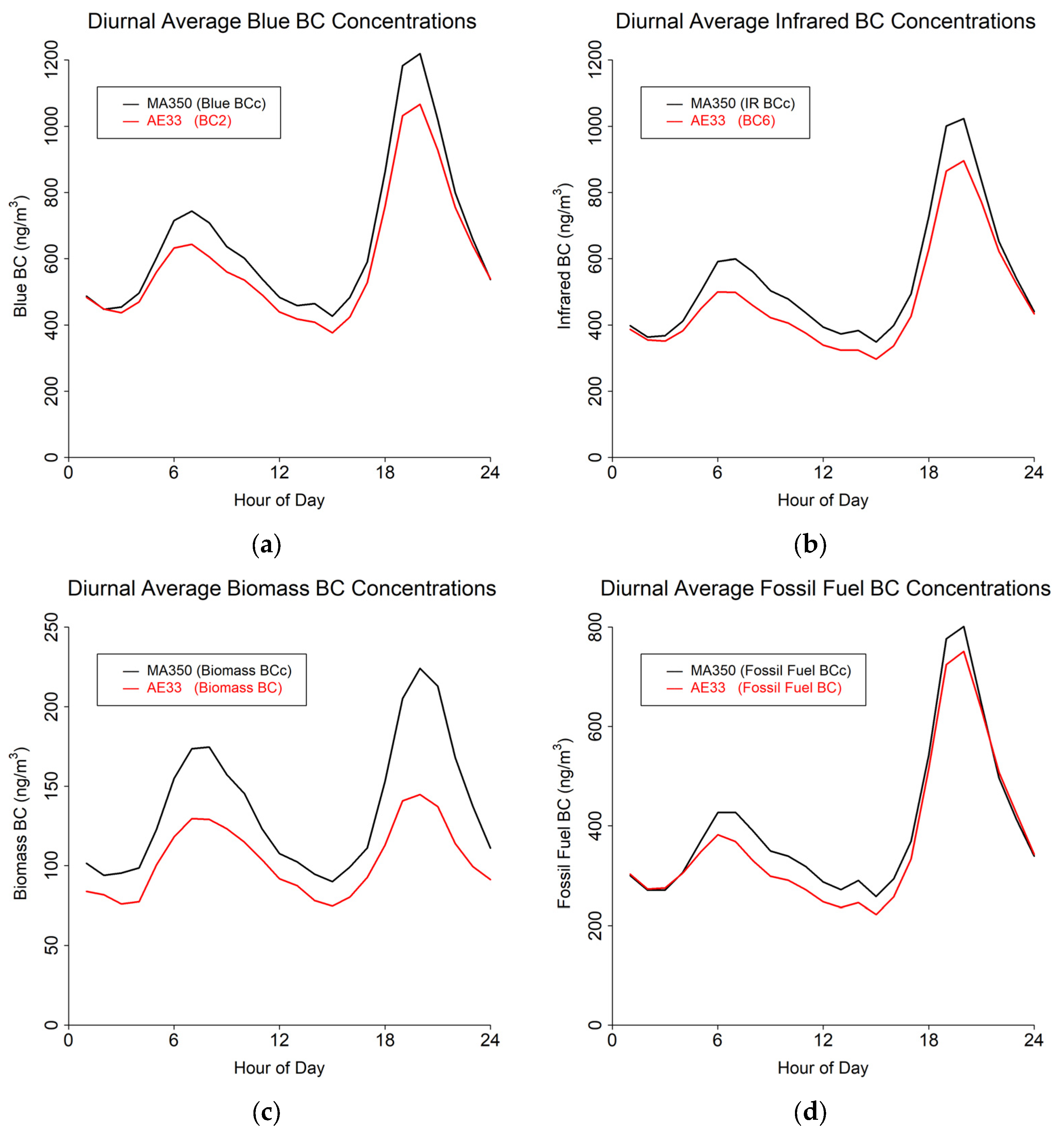
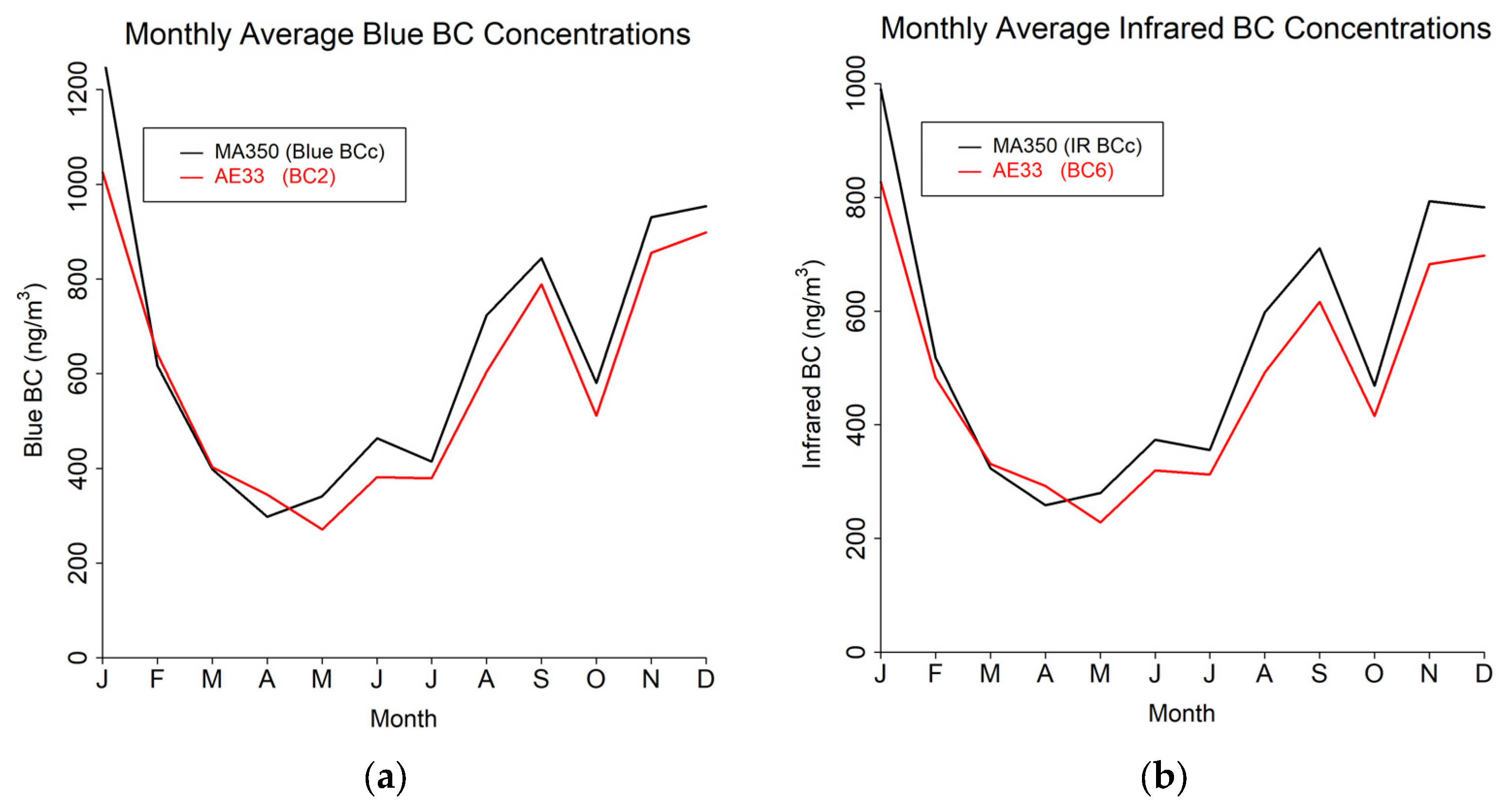

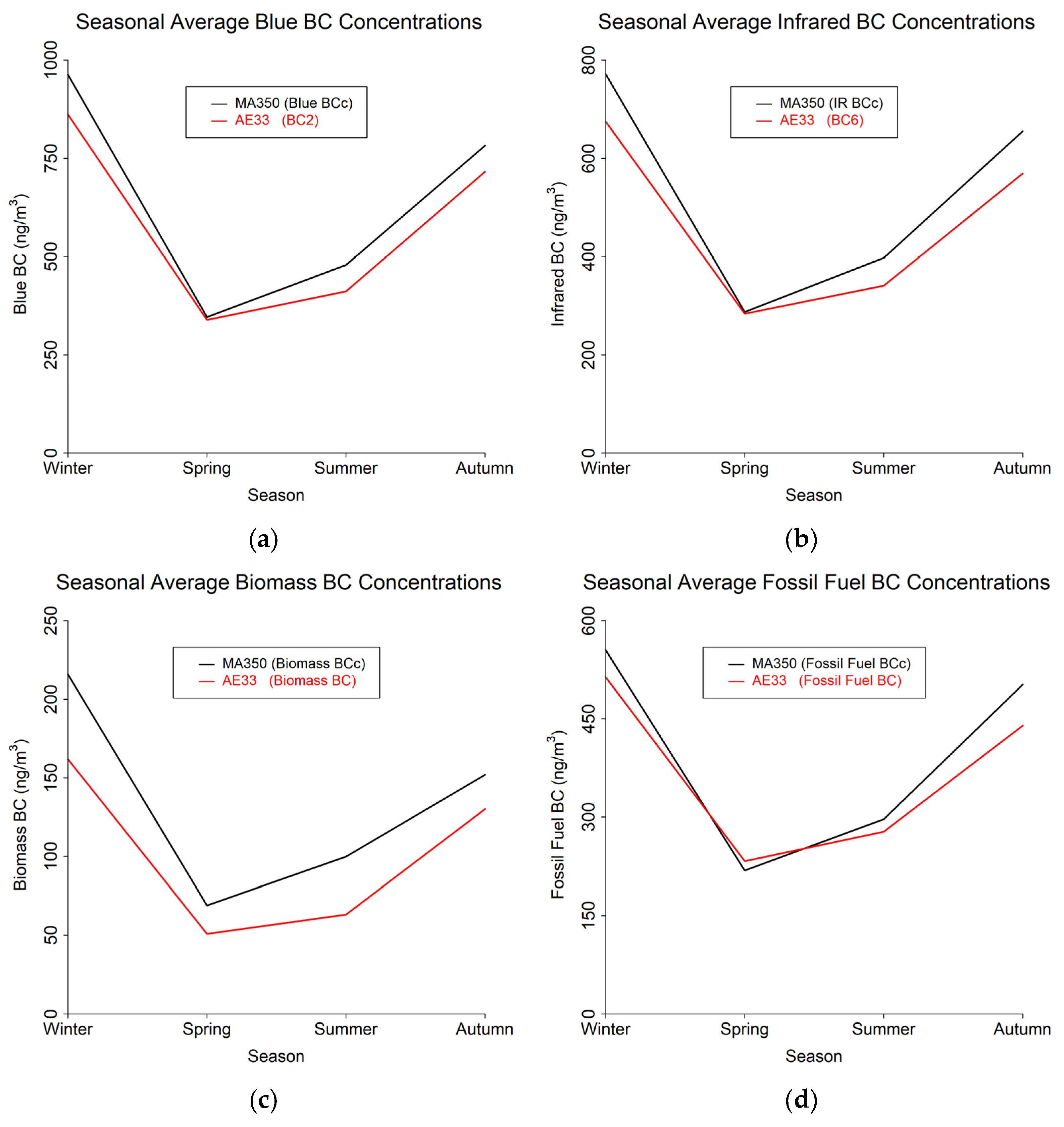

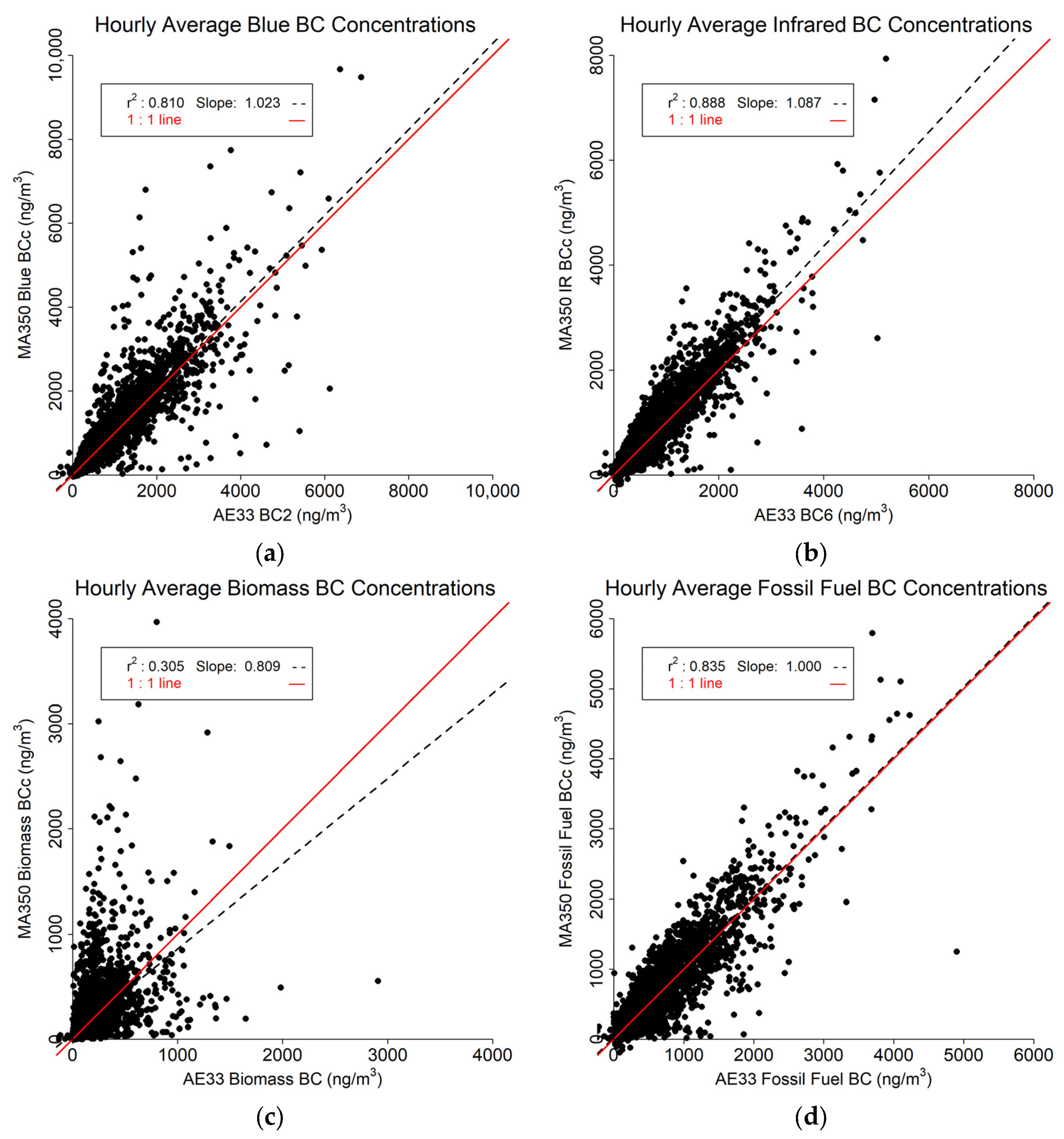

| MA350 | AE33 | |
|---|---|---|
| Wavelengths (nm) | 375, 470, 528, 625, 880 | 370, 470, 520, 590, 660, 880, 950 |
| Size | 7 cm × 10 cm × 20 cm, 1 kg | 28 cm × 43 cm × 33 cm, 21 kg |
| Flow | 0.050–0.170 L min−1 | 2–5 L min−1 |
| Detection Limit (IR BC) | 0.030 μg m−3 (300 s, SingleSpotTM) | <0.005 μg m−3 (3600 s) |
| Timebase | 1 s, 5 s, 10 s, 30 s, 60 s, 300 s | 1 s, 60 s |
| Loading Effects Compensation | DualSpot® | DualSpot® |
| Battery | Yes | No |
| WiFi | Yes | No |
| Instrument Status | # Observed |
|---|---|
| Tape advance or fast calibration | 2005 |
| Stopped | 1395 |
| First measurement | 1590 |
| Flow out of range | 0 |
| Check status history | 0 |
| Calibrating led | 5 |
| Optical test | 0 |
| Optical calibration error | 0 |
| Led error | 0 |
| Tape error | 1318 |
| Stability test | 4 |
| Clean air test | 68 |
| Change tape procedure | 2 |
| Leakage test | 66 |
| Clean air test unacceptable result | 0 |
| Instrument Status | # Observed |
|---|---|
| Tape advance | 138 |
| Start up | 5 |
| Flow unstable | 213 |
| Optical saturation | 0 |
| Sample timing error | 0 |
| Pump drive limit | 0 |
| User skipped tape advance | 0 |
| Tape jam | 0 |
| Tape at end | 0 |
| Tape transport not ready | 0 |
| Invalid date/time | 0 |
| Tape error | 0 |
| MA350 | AE33 | Inter-Device Difference | |
|---|---|---|---|
| IR BC (ng m−3) | 534 (774) | 474 (640) | 11% |
| Blue BC (ng m−3) | 651 (885) | 591 (804) | 9% |
| Biomass BC (ng m−3) | 136 (227) | 103 (183) | 24% |
| Fossil fuel BC (ng m−3) | 398 (519) | 370 (530) | 7% |
Disclaimer/Publisher’s Note: The statements, opinions and data contained in all publications are solely those of the individual author(s) and contributor(s) and not of MDPI and/or the editor(s). MDPI and/or the editor(s) disclaim responsibility for any injury to people or property resulting from any ideas, methods, instructions or products referred to in the content. |
© 2024 by the authors. Licensee MDPI, Basel, Switzerland. This article is an open access article distributed under the terms and conditions of the Creative Commons Attribution (CC BY) license (https://creativecommons.org/licenses/by/4.0/).
Share and Cite
Mendoza, D.L.; Hill, L.D.; Blair, J.; Crosman, E.T. A Long-Term Comparison between the AethLabs MA350 and Aerosol Magee Scientific AE33 Black Carbon Monitors in the Greater Salt Lake City Metropolitan Area. Sensors 2024, 24, 965. https://doi.org/10.3390/s24030965
Mendoza DL, Hill LD, Blair J, Crosman ET. A Long-Term Comparison between the AethLabs MA350 and Aerosol Magee Scientific AE33 Black Carbon Monitors in the Greater Salt Lake City Metropolitan Area. Sensors. 2024; 24(3):965. https://doi.org/10.3390/s24030965
Chicago/Turabian StyleMendoza, Daniel L., L. Drew Hill, Jeffrey Blair, and Erik T. Crosman. 2024. "A Long-Term Comparison between the AethLabs MA350 and Aerosol Magee Scientific AE33 Black Carbon Monitors in the Greater Salt Lake City Metropolitan Area" Sensors 24, no. 3: 965. https://doi.org/10.3390/s24030965
APA StyleMendoza, D. L., Hill, L. D., Blair, J., & Crosman, E. T. (2024). A Long-Term Comparison between the AethLabs MA350 and Aerosol Magee Scientific AE33 Black Carbon Monitors in the Greater Salt Lake City Metropolitan Area. Sensors, 24(3), 965. https://doi.org/10.3390/s24030965







